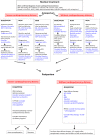Cardiomyopathy and pregnancy
- PMID: 31308064
- PMCID: PMC6839719
- DOI: 10.1136/heartjnl-2018-313476
Cardiomyopathy and pregnancy
Abstract
Cardiomyopathy is a group of disorders in which the heart muscle is structurally and functionally abnormal in the absence of other diseases that could cause observed myocardial abnormality. The most common cardiomyopathies are hypertrophic and dilated cardiomyopathy. Rare types are arrhythmogenic right ventricular, restrictive, Takotsubo and left ventricular non-compaction cardiomyopathies. This review of cardiomyopathies in pregnancy shows that peripartum cardiomyopathy is the most common cardiomyopathy in pregnancy. Peripartum cardiomyopathy develops most frequently in the month before or after partum, whereas dilated cardiomyopathy often is known already or develops in the second trimester. Mortality in peripartum cardiomyopathy varies from <2% to 50%. Few reports on dilated cardiomyopathy and pregnancy exist, with only a limited number of patients. Ventricular arrhythmias, heart failure, stroke and death are found in 39%-60% of high-risk patients. However, patients with modest left ventricular dysfunction and good functional class tolerated pregnancy well. Previous studies on >700 pregnancies in 500 women with hypertrophic cardiomyopathy showed that prognosis was generally good, even though three deaths were reported in high-risk patients. Complications include different types of supraventricular and ventricular arrhythmias, heart failure and ischaemic stroke. Recent studies on 200 pregnancies in 100 women with arrhythmogenic right ventricular cardiomyopathy have reported symptoms, including heart failure in 18%-33% of pregnancies. Ventricular tachycardia was found in 0%-33% of patients and syncope in one patient. Information on rare cardiomyopathies is sparse and only presented in case reports. Close monitoring by multidisciplinary teams in referral centres that counsel patients before conception and follow them throughout gestation is recommended.
Keywords: arrhythmogenic right ventricular dysplasia; heart failure; hypertrophic cardiomyopathy; idiopathic dilated cardiomyopathy; pregnancy.
© Author(s) (or their employer(s)) 2019. Re-use permitted under CC BY. Published by BMJ.
Conflict of interest statement
Competing interests: None declared.
Figures


References
-
- McKenna WJ, Maron BJ, Classification TG. epidemiology, and global burden of cardiomyopathies. Circ Res 2017;12:722–30. - PubMed
Publication types
MeSH terms
LinkOut - more resources
Full Text Sources
Medical
